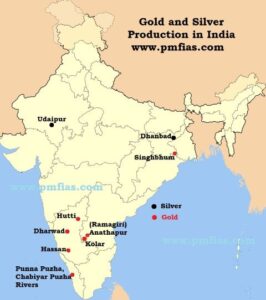CSIP: PRELIMS BOOSTER SERIES -531 GEOGRAPHY
GOLD IN INDIA
WHY IN NEWS?
Gold prices jump after rates increase by US Fed
BACKGROUND
Gold in its purest form is a bright, slightly reddish yellow, dense, soft malleable and ductile metal. It is one of the least reactive chemical elements and is solid under standard conditions. Gold often occurs in free elemental (native) form, as nuggets or grains, in rocks, in vein and in alluvial deposits
Gold is a relatively scarce metal in the world and a scarce commodity in India. The domestic demand is mainly met through imports.
DISTRIBUTION OF RESERVES/RESOURCES
IN TERMS OF PRIMARY ORE
Bihar (44%) followed by Rajasthan (25%), Karnataka (21%),West Bengal & Andhra Pradesh (3% each) and Jharkhand (2%).
IN TERMS OF METAL CONTENT
Karnataka remained on top followed by Rajasthan, Andhra Pradesh, Bihar, Jharkhand
PRODUCTION
Karnataka is the largest producer of gold in India followed by Andhra Pradesh.
DISTRIBUTION OF RESERVES ACROSS STATES
KARNATAKA
- Gold mines are located in Kolar [Kolar Gold Field], Dharwad, Hassan and Raichur [Hutti Gold Field] districts
ANDHRA PRADESH
- Ramagiri in Anantapur district is the most important gold field in AP.
- Alluvial Gold [gold scattered in silt] and Placer deposits [gold bearing rocks] in small quantity are widely spread in a large number of rivers
JHARKHAND
- The state hosts both load and placer deposits. The deposits are found in Singhbhum district and other regions
of the Chota Nagpur plateau and as placer deposits along Subarnrekha river
ASSAM
- It is reported to occur in sands, gravels and alluvial terraces along the Subansiri river, the Lohit-Brahmaputra and other rivers in Lakhimpur, Darrang and Sibsagar
KERALA
- The river terraces along the Punna Puzha and the Chabiyar Puzha have some alluvial gold.
RAJASTHAN
- Udaipur Banswara region


